
Forget the capes and the cosmic threats. In the real world, superheroes sweat about box office numbers, not saving the planet. This isn’t about good vs. evil, it’s DC vs. Marvel in a data duel. We’re talking hard numbers, folks. The kind that make studios green with envy (or red with worry).
Here’s the thing: critical acclaim is nice, but it doesn’t pay the bills. We’re going to dissect the blockbuster machine, peeling back the layers to see how these movies get made. We’ll crack the code on budgets, critical reception, and most importantly, what it means for the heroes you see on screen.
This is data analysis, superhero style.

When we line up Marvel and DC at the box office, Marvel clearly leads the charge with a staggering $44.75 billion in global revenue, leaving DC’s respectable $15.12 billion a bit in the dust. This isn’t just about who’s bringing in more bucks; it’s a tale of different strategies and how audiences have responded over the decades.
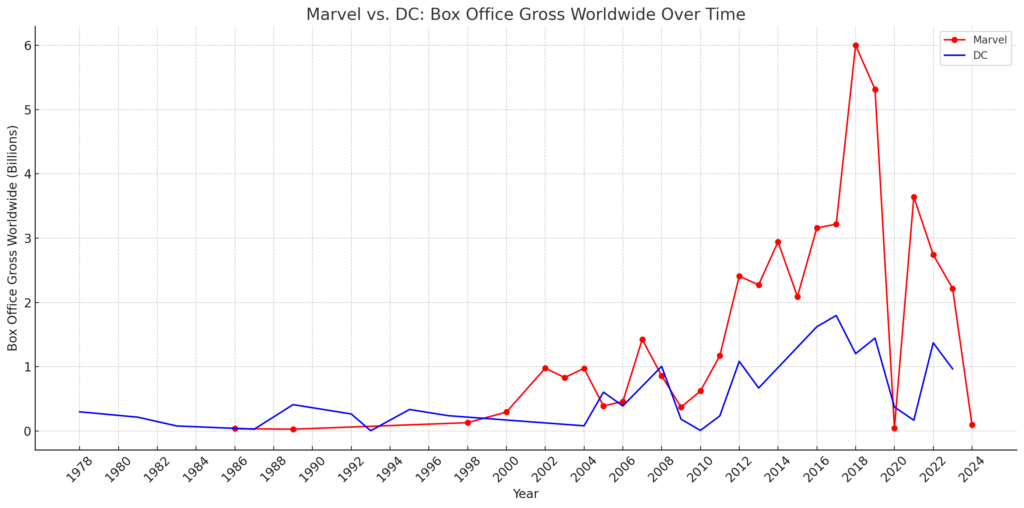
The journey through the box office over the years shows Marvel’s explosive growth since the mid-2000s, thanks to its Cinematic Universe, reshaping superhero cinema. DC’s journey, marked by significant highs with certain franchise releases, shows a more varied path. It’s a dynamic competition, but also a look back at how superhero films have consistently captured imaginations.
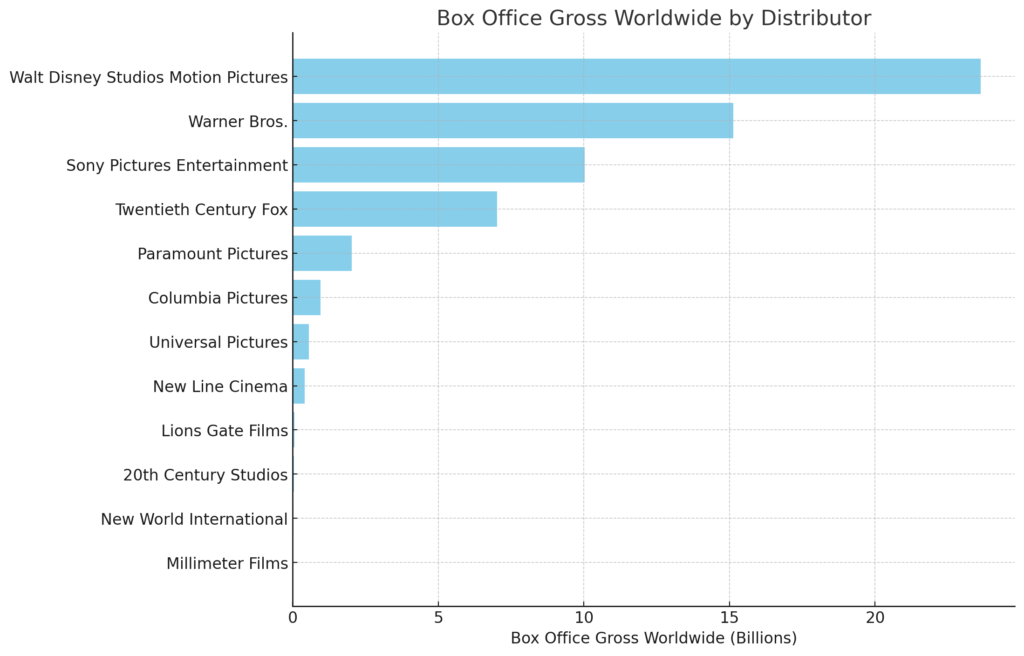
Digging further into the finances, looking at which major film distributors are making superhero bank, puts Disney at the top thanks to its Marvel goldmine with an astonishing $23.62 billion, with Warner Bros. not too far behind with a commendable $15.12 billion, championing DC. The landscape shows not just who’s making what but highlights the competitive, yet richly varied, superhero ecosystem.
Sony Pictures Entertainment and Twentieth Century Fox also make significant contributions to the landscape, showcasing their roles in expanding the Spider-Man universe and the X-Men series, respectively.
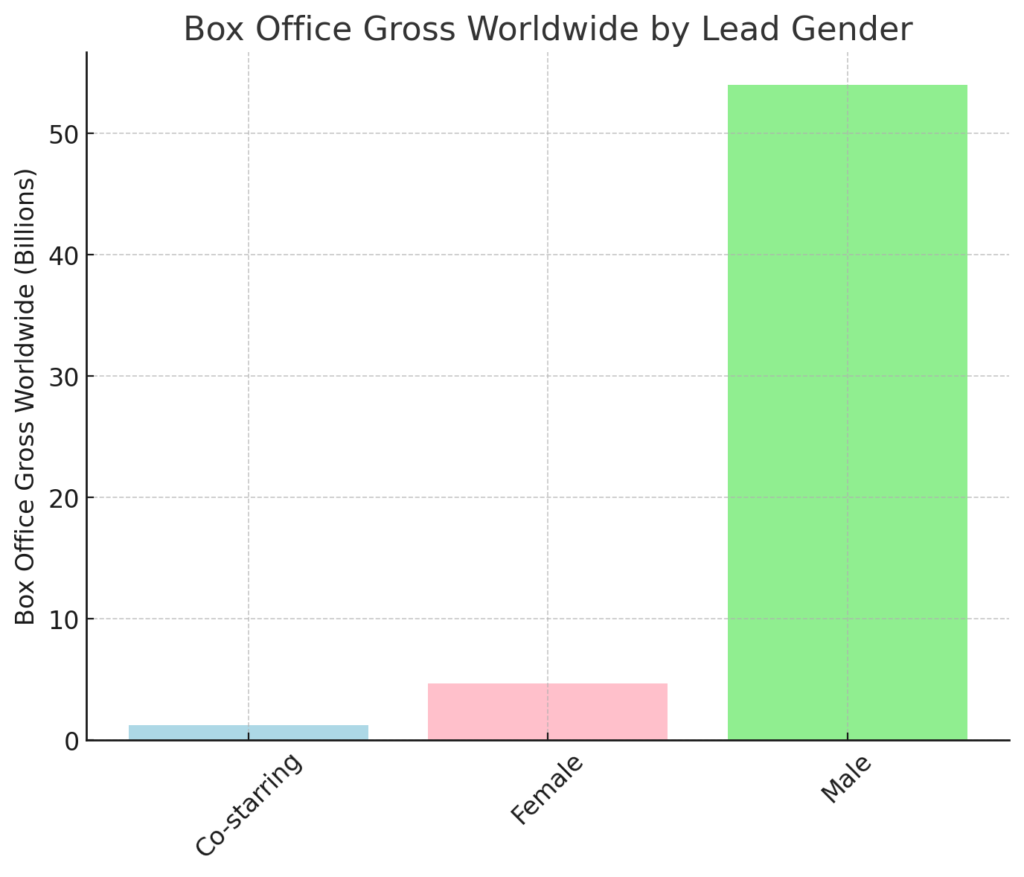
Now, let’s talk about gender roles in these blockbusters. The chart above vividly illustrates the worldwide box office gross differentiated by the gender of leading roles in movies, segmented into three categories: co-starring roles, female-led, and male-led films.
With male-led movies amassing a staggering $54 billion, they dominate the box office, reflecting both the volume of male-led superhero and blockbuster films and their widespread commercial appeal.
Female-led films, while significantly lesser in total gross at approximately $4.67 billion, showcase the growing market and critical reception of movies that feature women in central roles, hinting at an evolving landscape in cinematic storytelling and audience preferences.
Co-starring films, which likely include ensemble casts or dual leads, present a modest gross of $1.2 billion, suggesting a niche yet impactful segment of the market.
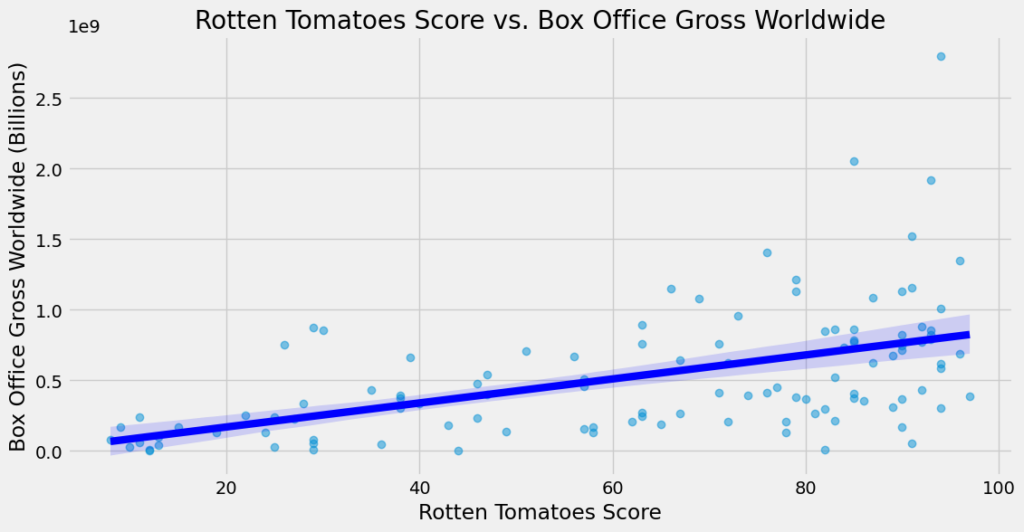
Analyzing the blend of Rotten Tomatoes scores with box office success gives us a peek into how critical acclaim and audience love don’t always align but tend to trend towards movies doing well when critics give the thumbs up.
The distribution of points suggests a positive correlation, as indicated by the upward trend of the fitted regression line. Most of the data clusters between scores of 20 to 100, with a notable increase in box office revenue as the Rotten Tomatoes score improves. The concentration of points towards the lower end of the box office gross indicates that while higher scores are generally associated with greater revenue, there are also many high-scoring movies that did not translate critical acclaim into box office success.
The transparency of the points allows us to observe the density of data in different score ranges, and the broad spread across the box office axis reflects the variability in commercial success. This visual analysis may suggest that while good reviews can be associated with higher earnings, they are not the sole determinant of financial performance, as indicated by outliers and the spread of data.
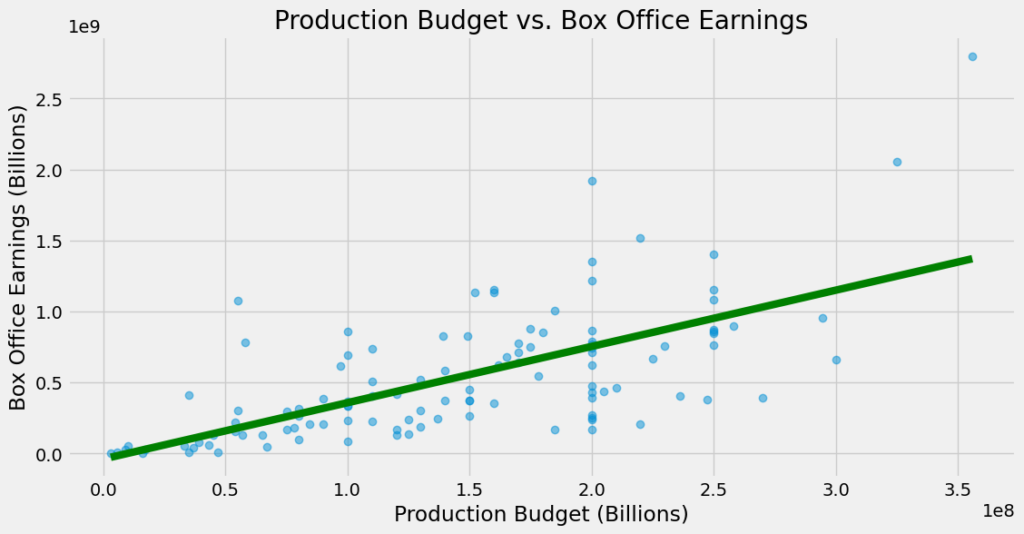
The story’s similar when we look at production budgets versus earnings, suggesting that splurging on a movie often (but not always) pays off.
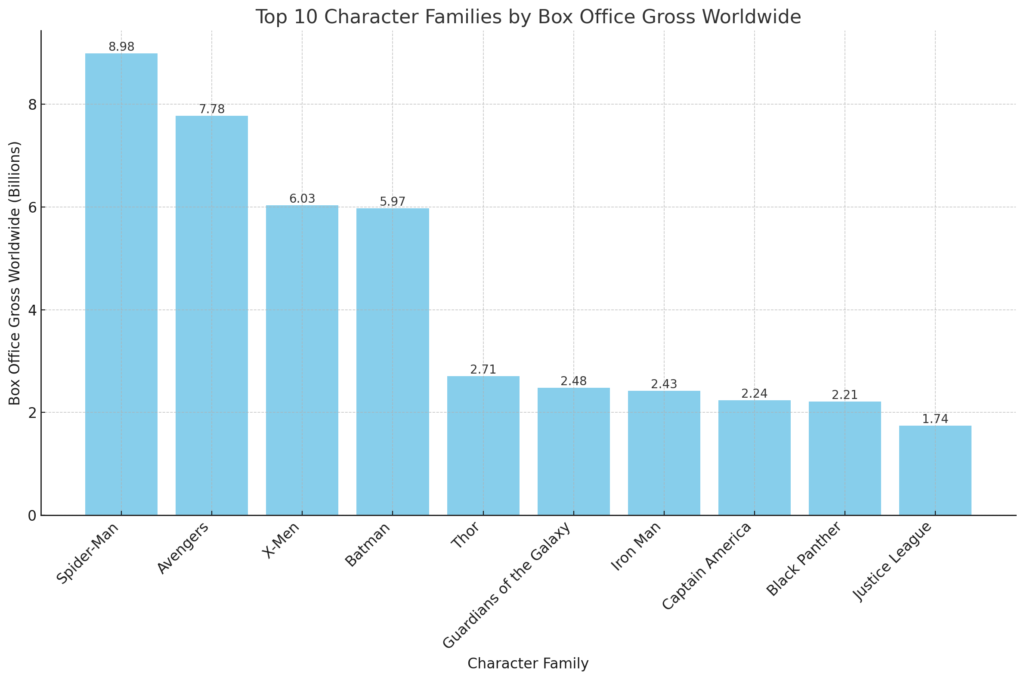
Diving into the realm of character families, Spider-Man and The Avengers lead the pack with an impressive $8.98 billion and $7.78 billion respectively with their box office gold showcasing the enormous pull of these iconic heroes. The “X-Men” and “Batman” franchises also hold significant positions, with box office grosses of $6.03 billion and $5.97 billion, respectively, underlining their enduring appeal.
The character families with lesser box office gross, such as “Thor,” “Guardians of the Galaxy,” “Iron Man,” “Captain America,” “Black Panther,” and “Justice League,” each with grosses ranging from approximately $1.74 billion to $2.71 billion, find themselves on the lower end of the chart. While still highly successful, these franchises have fewer films compared to giants like “Spider-Man” and “Avengers,” limiting their cumulative box office potential.
Additionally, the development of these characters’ storylines and their integration into the wider cinematic universe might impact their standalone grossing capability. For example, “Black Panther” and “Captain America” have seen significant box office success, but their total is constrained by the number of films within their specific sagas.
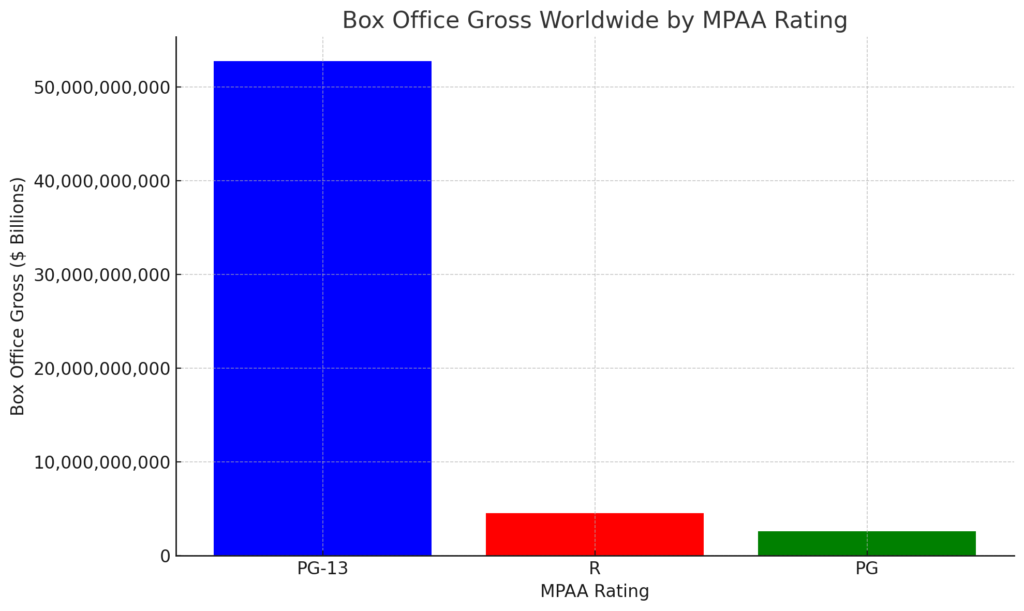
Lastly, the PG-13 rating is the sweet spot for box office gold, striking a balance that draws in teens and adults alike, with “Avengers: Endgame” standing as a towering example of hitting it right with $2.8 billion worldwide.
PG-13 movies have dominated, grossing a staggering $52.74 billion and dwarfing the earnings from R-rated and PG films, which are represented by significantly shorter red and green bars, with grosses of $4.52 billion and $2.62 billion, respectively. This underscores the commercial viability of PG-13 movies, which, while accessible to younger audiences, still manage to incorporate a level of sophistication and intensity that appeals to adults.

Wrapping up all this superhero box office talk, it’s pretty clear these movies are more than just a big deal—they’re a money-making machine, especially the PG-13 films from Marvel. They’ve found the cheat code: mixing epic action with stories everyone can relate to, and it’s paying off. This analysis shows us that when movies hit that sweet spot with critics and fans, they’re not just winning awards; they’re breaking the bank. Superhero flicks have changed the game, making way for new ways to tell stories and generate revenue.
Looking at how things are shaking up with more diverse leads and the box office gold they’re bringing in is encouraging. It’s showing Hollywood that mixing things up and giving everyone a hero they can relate to isn’t just a good idea—it’s great for business.
And while throwing tons of cash at a movie tends to mean more bucks at the box office, at the end of the day, it’s really about getting viewers hooked with layered stories and characters we care about. The big takeaway? As long as superhero movies keep evolving and staying relatable to fans, they’re going to stay on top. The real challenge for those behind these movies is keeping us all coming back for more while finding fresh, exciting ways to surprise us.